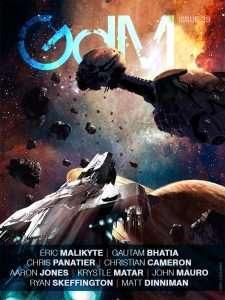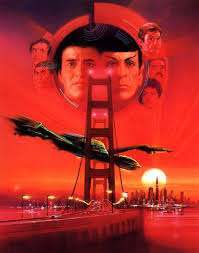Science Fiction and the Dark Side of the Future
Science fiction is one of the most popular genres in literature, film, and TV. It’s easy to see why: aliens, space exploration, time travel, parallel universes, advanced technology; there are endless possibilities within the genre and freedom for writers to share their hopes or concerns of today’s world through their stories. Often, sci-fi will overlap with fantasy and horror, and whilst the genre allows for hope and excitement as we think about the endless possibilities humans may be capable of, there is a flipside that I enjoy even more: what horrors may await us in the future? What dangers do we need to be concerned about as we push technology further and further? There are many great pieces of science fiction that have been written as warnings about what may come to pass as humanity progresses as a species. What can we learn about them whilst watching with a bucket of popcorn?
 What makes us human?
What makes us human?What makes us human? This is a question that has become more prevalent as technology has advanced. Robots are steadily getting more lifelike while games and films are using CGI that get closer to reality than many thought possible, and writers have pondered what may happen when our eyes are unable to distinguish the difference between humans and their creations. Arguments have overtaken the internet about AI-influenced illustrations and writings as some feel the soul of humanity is being lost in such create explorations whilst others feel that the speed of the work (and cost) gives weight to its future use. Do we have to be worried about the realism found in AI? If we pay attention to sci-fi, then perhaps we do.
The Matrix is one of the most critically acclaimed pieces of science fiction ever created. In a world where most humans live in a simulation created by intelligent machines to distract them whilst using their bodies as an energy source, a few humans become aware of the true world and fight to save humanity. The machines had won the war against humans after humans had tried blocking out the sun and then created a world where humans were unable to distinguish what is real and what isn’t. They were unable to process earlier versions of the world which were more like a utopia (fans of grimdark will definitely understand this!).
Ridley Scott’s Blade Runner is a science fiction classic that has the audience (and its characters) questioning who is human and how can we prove it. Harrison Ford’s Decker is tasked with killing a group of violent, lifelike androids. As he progresses with his mission, he begins to question his own identity. It is a powerful story with superb acting and some of the best cinematic lines in history (lost like tears in the rain…) and designed in a way that makes the audience sympathise with the plight of the androids and question the actions of the humans. The danger of AI is part of pop culture now with most people recognising HAL 9000 from 2001: A Space Odyssey and Arnie’s Terminator from James Cameron’s brilliant films—I wonder if we will heed their warnings.
 Are we alone?
Are we alone?Space… the final frontier. Star Trek showed us a universe where we are but one of many species scattered around space. War of the Worlds, Star Wars, Men in Black, ET, Independence Day, A Quiet Place, Predator; all these films and shows examine whether we are alone in the universe. In some, the aliens we meet are friendly and warm, in others… not so much. We have sent robots (them again…) out into space in search of life and it’s exciting to think of the possibilities. But what would happen if we found something out there? If you want sci-fi horror, then look no further than Alien. Directed by Ridley Scott (him again…) it follows the story of a crew on a commercial space shuttle who accidentally discover and let loose the titular beast on their spaceship. The horror builds beautifully with scenes meant to scar even the toughest of audience members. Chest-busting, acidic blood, narrow corridors, and terrifying practical designs by Swiss artist H. R. Giger will make most people wish that maybe we are alone after all. Sigourney Weaver as Ripley is often heralded as one of the great female leads in all film, not just science fiction as she acts with common sense and bravery seemingly not found in many sci-fi or horror films.
It is a genre that has displayed powerful women for longer than many others: Sarah Connor (Terminator), Uhura and Janeway (Star Trek), Louise Banks (Arrival), Buffy Summers and the rest of the gang (Buffy), Scully (X-Files), among others. Science fiction has, at times, been a genre (especially with TV and film) that is forward thinking not just in terms of story but diversity as well. Many fans of the genre argue for the title of Mother of Sci-fi to be attributed to Mary Shelley, the author of Frankenstein in 1818 when she was only eighteen years old. Writing a tale of a scientist obsessed with his work and ignoring the ethical and social consequences has almost become a blueprint for others (just take a look at Jurassic Park, Westworld, etc.), and it kickstarted a genre filled with powerful women.
 A Dystopian Future
A Dystopian FutureActions undertaken today will impact the future. Yet, we still make mistakes such as pollution, global warming, advanced weapons. The pessimist in some writers can only see this leading humanity into a dark future with pain and suffering. Last year’s blockbuster hit was Christopher Nolan’s brilliant Oppenheimer. The difficult aspect of watching that film was knowing that the story it was telling was true and understanding that it was not the end of war but the start of something that could be much more dangerous. Weapons advance at a startling rate and threaten the existence of life as we know it. Since the Cold War, writers have warned of the dangers of what may be before us. Fallout shows a future where nuclear bombs destroyed much of the known world. A few rich people were able to hide in vaults whilst survivors on the surface lived in a harsh wasteland with little rule and monstrosities seemingly around every corner. Even more terrifying is the fact that humanity didn’t seem to learn anything—they continued hurting one another in the same ways.
Fallout, Mad Max, The Walking Dead, and The Last of Us are cautionary stories are cautionary tales about what could happen when everything we know is stripped away from us.
At its core, sci-fi explores humanity and its actions through the lens of unparalleled possibilities. Sometimes, the tales are too close to home (watching Contagion after living through a pandemic was eye-opening) and we are able to recognise the people and actions as ones that we have seen before. District 9 may use aliens for entertainment value but the documentary style and actions of the characters shine a light on South African history and makes for some uncomfortable viewing.
Science fiction gives us both the brightest lights and the darkest depths. The stories show us the best of what we may become and warn us of the dangers if we follow certain paths. These themes allow us to take a good hard look at ourselves as we dream of the future. For fans of grimdark who haven’t dipped their toes into the dark depths of science fiction, now might be the time.
This essay was originally published in Grimdark Magazine #39.
Read Grimdark Magazine #39The post Science Fiction and the Dark Side of the Future appeared first on Grimdark Magazine.



